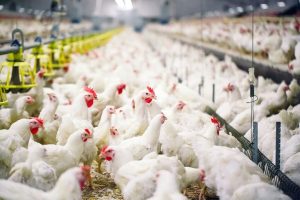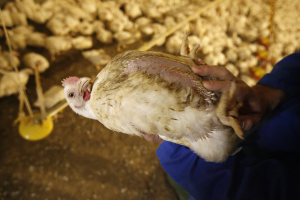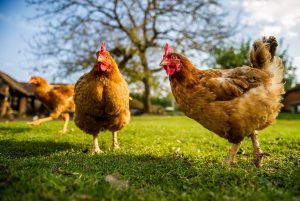Importance of the intestinal growth in chicken:
Chickens are a major human need in this modern era, and their intestinal growth is an important factor in getting maximum productivity out of them. Let’s have a deep dive into how intestinal growth can be improved in chickens.
Chickens, widely raised for meat and eggs. often receive antibiotics on commercial farms to prevent illness, potentially impacting their intestinal growth. As a result we humans damage intestinal growth in the chickens. Now we will discuss that how intestinal growth of chickens damages through various methods.
These days Chickens are the most popular proteins source, but their intestinal growth can be problematic. Chickens develop large intestines to extract all the fundamental nutrients from their daily poultry feeds. Balancing this with their health can be challenging, but certain companies have devised methods to enhance chicken intestinal growth without compromising their well-being.
Approaches and Strategies For Intestinal Growth of Chickens:
When discussing the intestinal growth of chickens we can get maximum results if we provide them a good daily poultry feed intake for maximum productivity.
Chickens have a fast intestinal growth rate to maintain their good FCR (Feed conversion rate), which can lead to problems. To improve their intestinal growth rate (FCR), the chickens always need good quality of feed and water and plenty of fresh air. Moreover chickens needs a good access to move around.
If we want to get maximum intestinal growth of chickens then we have to feed them a high-quality diet that should be toxin-free. A high-quality poultry feeds is a mixture of good grains or fresh fruits and vegetables and vitamins and minerals. Those Chickens who are fed a high-quality poultry feed will have improved intestinal growth and be less likely to develop digestive problems.
A key challenge is enhancing intestinal growth affordably and safely. Recent research advocates for the use of polydimethylsiloxane (PDMS), commonly found in medical devices. This material, known for safety, can aid in providing essential nutrients and oxygen, fostering better health and feed efficiency in chickens.
INTESTINAL GROWTH CHICKEN AND DEVELOPMENT:
we can get a quality intestinal growth if we provide our chickens more fiber feed. It is witnessed that the Chickens who were fed a diet with more fiber tend to have healthier intestines because the poultry feed was not made with chemicals and other substances that can harm the gut. Fiber also improve the digestibility and keep the stomach empty, making it easier for the chicken to digest food.
With a versatile gastrointestinal tract, chickens can process diverse foods and utilize a crop for storage or egg production. Optimal intestinal growth is achieved through a balanced diet and suitable surroundings. A high-quality ration rich in fiber, minerals, and vitamins results in larger and more efficient intestines, facilitating rapid weight gain and reducing the risk of health issues. Chicken owners can enhance intestinal health by providing varied environments like brooder houses, coops, or sunlit outdoor spaces.
Witnessing a remarkable surge, the villi’s height and perimeter displayed a striking increase ranging from 34% to a staggering 100% across all small intestinal segments during the critical period of 4 to 10 days. Notably, as age advanced, crypt depth and the count of enterocytes per villi demonstrated a consistent rise, unveiling the dynamic evolution within the intricate realm of intestinal development.
INTESTINAL DEVELOPMENT–POSTHATCH ENVIRONMENT:
Enhancing the intestinal growth of chickens sparks numerous discussions, with various ideas in the spotlight:
- Give them access to fresh, clean water.
- Feed them a high-quality diet that includes plenty of fresh vegetables and fruits.
- Provide them fresh high quality air, comfortable, safe environment to live and eat.
- Exercise them regularly, both indoors and outdoors.
- Give them plenty of high-quality grains.
INTESTINAL DEVELOPMENT–MICROBIAL INTERACTIONS:
Intestinal growth in chickens can be improved by improving the intestinal microbiota. Improving the intestinal microbiota can involve manipulating the environment, adding specific probiotics, or using antibiotics selectively.
intestinal growth. As they burgeon in the early stages, their intestines hit a limit, hindering further growth. This poses an issue as the intestines play a crucial role in nutrient absorption and waste elimination.
Failed intestinal growth leads to improper digestion, causing health woes for the chickens. A remedy lies in fostering beneficial bacteria development within their intestines. Introducing probiotics, microorganisms supporting gut health, becomes a key strategy to nurture chicken well-being.
Additionally, to keep the bad bacteria count low we need to keep the surroundings clean and fresh. if we do this practice, we can help your chickens to grow healthy intestines and gut that can handle all of the nutrients they need to thrive.
One of the essential aspects of poultry production is the intestinal growth of the poultry birds. Chickens ingest a lot of feed, and their intestines need to grow to process all that food in a normal way. If there is any problem in intestines and they don’t develop properly, then the chickens will not be able to digest their food and will not perform well. There are Several factors that can affect intestinal growth, including bacterial interactions.
Probiotics can improve intestinal growth of our birds. Probiotics are healthy bacteria that are good for chicken’s gut health and can help promote intestinal development in chickens to get maximum FCR. They can also minimize the number of antibiotics needed to treat chicken infections, which is beneficial because antibiotics can negatively affect the environment.
DIGESTIVE ENZYMES:
Numerous digestive enzymes cater to chickens, each playing a vital role. Proteases, like bromelain from pineapple, break down proteins, amylases from grains and legumes tackle carbohydrates, and lipases handle fats. Esterified and non-esterified lipases are key players in breaking down fats. Choosing the right enzymes ensures optimal digestion and nutrient absorption for our poultry birds.

Digestive enzyme activities of intestinal growth:
Chickens are a poultry breeds that we keep to get their meat or eggs. As chickens have a short intestinal tract that allows them to digest food quickly. So this is beneficial as chickens can be raised quickly and efficiently to serve the purpose, but it also means that their intestinal contents are not as digestible as they could be.
Digestive enzyme good performance can optimize intestinal growth content by adding proteases, amylases, and lipases to the poultry feeds. As a result complex proteins and carbohydrates form into amino acids, sugars, and fats, which the chickens can digest more easily.
The digestive enzyme performance of intestinal growth contents can be improved by adding a digestive enzyme to the poultry feed. Enzyme supplementation also enhances digestion and absorption of nutrients in the feed as a result we get a very good feed conversion rate. Adding digestive enzyme supplements to chicken feed has shown a positive impact, leading to increased weight gain and improved feed efficiency.
Chickens as primary producers, rely on a robust digestive system with a large intestine for effective digestion. The process of intestinal growth is fueled by the breakdown of food consumed by chickens as they eat plentifully for growth. However, this growth can lead to challenges such as blockages and methane production. A recent study delved into measuring digestive enzyme activities in intestinal growth contents, revealing lower enzyme actions compared to standard intestinal content. Despite this, the overall digestibility remained high, offering insights that could enhance chicken feed digestibility and mitigate issues linked to intestinal growth.
- Chickens, integral to modern dietary needs, rely on efficient intestinal growth for optimal productivity.
- Antibiotics on commercial farms may impact chickens’ intestinal growth, affecting their overall health.
- Balancing large intestines’ growth with health is crucial; certain companies explore methods for enhancement.
- Strategies for optimal intestinal growth include quality feed, a toxin-free diet, and advancements like PDMS material.
- Fiber-rich diets and varied environments foster healthy intestines, emphasizing the importance of digestive health in poultry.Question 1:
How does antibiotic use impact the intestinal growth of chickens?
Answer: Antibiotics, commonly administered to prevent illness in chickens on commercial farms, can potentially hinder intestinal growth. This practice, aimed at human needs, inadvertently affects the digestive health of chickens, highlighting the complex relationship between modern practices and poultry well-being.Question 2:
What are the strategies for optimal intestinal growth in chickens?
Answer: Strategies for optimal intestinal growth include providing quality feed, maintaining a toxin-free diet, and exploring advancements like the use of PDMS material. Additionally, fiber-rich diets and varied environments are emphasized for fostering healthy intestines in chickens.Question 3:
How can digestive enzyme supplementation impact the intestinal growth of chickens?
Answer: Digestive enzyme supplementation has shown a positive impact on the intestinal growth of chickens. By adding proteases, amylases, and lipases to poultry feeds, complex proteins and carbohydrates break down into more digestible forms, leading to increased weight gain and improved feed efficiency in chickens.


Someone essentially help to make seriously posts I would state. This is the first time I frequented your web page and thus far? I surprised with the research you made to make this particular publish extraordinary. Great job!
Wohh precisely what I was searching for, appreciate it for posting.
Thankyou for all your efforts that you have put in this. very interesting information.
Thank you for another informative website. Where else may I am getting that type of information written in such an ideal approach? I have a undertaking that I’m simply now running on, and I’ve been on the look out for such info.
I like this blog its a master peace ! Glad I noticed this on google .
I’m not sure why but this website is loading very slow for me. Is anyone else having this issue or is it a problem on my end? I’ll check back later on and see if the problem still exists.|
Magnificent website. A lot of useful information here. I¦m sending it to a few buddies ans also sharing in delicious. And naturally, thank you for your effort!
Effective model: Power, business, relationships
The best site about Power
Thank you for your comment! We appreciate your interest in staying updated. Our website strives to provide the latest and most relevant information. Feel free to explore the various sections, and if you have any specific queries, we’re here to help!
Cheap Yeezy Slide sandals are the epitome of summer chic, providing comfort and style in equal measure for sun-soaked adventures.